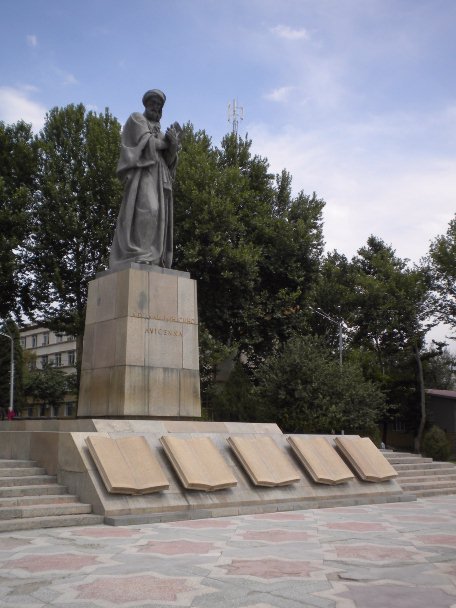

![]() Im westlichen Teil der tadschikishen Hauptstadt Duschanbe, dort wo die Hauptstraßen
Abu Ali ibn Sina Prospekt (Проспект
Абу Али ибн
Сино)
und Ismail Somoni Prospekt (Проспект
Исмоила Сомони)
sich kreuzen befindet sich ein monumentales Denkmal für
Abu Ali
ibn Sina (Avicenna). Hierbei werden nicht die mathematischen Leistungen hervorgehoben,
sondern seine Bedeutung als Arzt. Die fünf symbolisierten Bücher an der Frontseite
des Sockels reflektieren auf sein fünfbändiges Werk Kanon der Medizin, das
lange Zeit als Standardwerk
galt1).
(Diese Information ist dem Artikel entnommen, auf den in Fußnote 2) verwiesen wird.)
Auf der Vorderseite der Stele, die das mächtige Standbild trägt ist der Name
Abu Ali ibn Sino in kyrillischer Schrift nebst der latinisierten Form Avicenna
zu lesen. (Weitere Hinweise wie Künstler, Jahresangabe oder Ähnliches sucht man
am Denkmal allerdings
vergebens2).)
Im westlichen Teil der tadschikishen Hauptstadt Duschanbe, dort wo die Hauptstraßen
Abu Ali ibn Sina Prospekt (Проспект
Абу Али ибн
Сино)
und Ismail Somoni Prospekt (Проспект
Исмоила Сомони)
sich kreuzen befindet sich ein monumentales Denkmal für
Abu Ali
ibn Sina (Avicenna). Hierbei werden nicht die mathematischen Leistungen hervorgehoben,
sondern seine Bedeutung als Arzt. Die fünf symbolisierten Bücher an der Frontseite
des Sockels reflektieren auf sein fünfbändiges Werk Kanon der Medizin, das
lange Zeit als Standardwerk
galt1).
(Diese Information ist dem Artikel entnommen, auf den in Fußnote 2) verwiesen wird.)
Auf der Vorderseite der Stele, die das mächtige Standbild trägt ist der Name
Abu Ali ibn Sino in kyrillischer Schrift nebst der latinisierten Form Avicenna
zu lesen. (Weitere Hinweise wie Künstler, Jahresangabe oder Ähnliches sucht man
am Denkmal allerdings
vergebens2).)
Die Fotos wurden im August 2012 aufgenommen.
1) Folgt man der Argumentation der Biografie zu Abu Ali ibn Sina so könnten die fünf Bücher genauso den einbändigen Kanon der Medizin sowie die vier Bände Das Buch der Heilung (Kitab al-Shifa') darstellen, wobei davon ein Band den mathematischen Disziplinen gewidmet ist. (Zurück zum Bezug)
2) Dieser kurze Artikel weist R. Karimov, A. Aharon als Architekten und G. Eldar als Bildhauer aus. Das Denkmal wurde 1984 zum 1000. Geburtstag von Avicenna errichtet (bezüglich des allgemein akzeptierten Geburtsjahres 980 etwa vier [Sonnen-]Jahre später). (Zurück zum Bezug)
![]() In the western part of the Tajikian capitol Dushanbe there is a huge monument for
Abu Ali
ibn Sina (Avicenna) exactly at the junction of the main roads Abu Ali ibn Sina
Prospekt (Проспект
Абу Али ибн
Сино)
and Ismail Somoni Prospekt (Проспект
Исмоила Сомони).
But the monument focusses not on the achievements in mathematics and related fields but
rather more to medicine. The five symbolized books at the front side of the base are
expected to be the five volumes of his work Canon of the Medicine which was standard
for a long time1). (This
information is taken from the short article to which is referenced from footnote 2).) The
front face of the stele shows the name Abu Ali ibn Sino in Cyrillics as well as the
latinized form Avicenna. (More information with respect of the artists, the year of
inauguration etc. is not obvious from the monument
itself2).)
In the western part of the Tajikian capitol Dushanbe there is a huge monument for
Abu Ali
ibn Sina (Avicenna) exactly at the junction of the main roads Abu Ali ibn Sina
Prospekt (Проспект
Абу Али ибн
Сино)
and Ismail Somoni Prospekt (Проспект
Исмоила Сомони).
But the monument focusses not on the achievements in mathematics and related fields but
rather more to medicine. The five symbolized books at the front side of the base are
expected to be the five volumes of his work Canon of the Medicine which was standard
for a long time1). (This
information is taken from the short article to which is referenced from footnote 2).) The
front face of the stele shows the name Abu Ali ibn Sino in Cyrillics as well as the
latinized form Avicenna. (More information with respect of the artists, the year of
inauguration etc. is not obvious from the monument
itself2).)
The photographs were taken in August 2012.
1) Following the arguments of the biography of Abu Ali ibn Sina the five books may represent the Canon of Medicine together with the four volumes of the Book of Healing (Kitab al-Shifa') from which one of the volumes contains mathematical and related material. (Back to the reference)
2) This short article names R. Karimov and A. Aharon being the architects and the sculptor G. Eldar. The monument was erected in 1984 for the 1000th anniversary of Avicennas birth. This is about four years too late with respect to the widely accepted birth in 980. (Back to the reference)

| Back to the main page | Created by Wolfgang Volk in August 2012 |